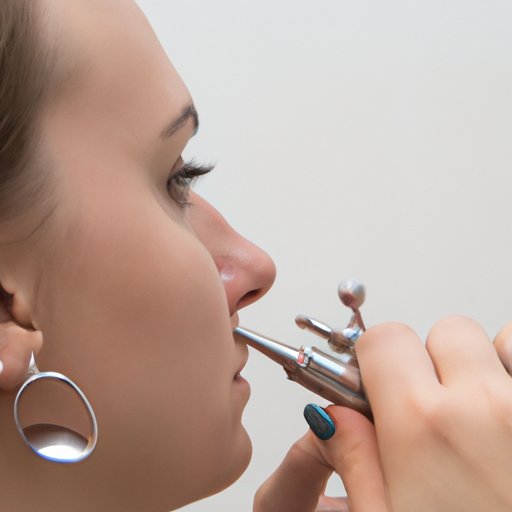I. Introduction
Are you eager to take out your new earrings but wondering how long you should wait to do so? Earrings are a stylish accessory for any outfit, but it’s important to follow proper aftercare and safety guidelines when leaving them in or taking them out. In this article, we will provide you with a guide to safe earring removal, including when you can remove them, the aftercare of pierced ears, healing time, and tips for safe removal.
II. A Guide to Safe Earring Removal: When Can You Take Them Out?
It’s essential to understand the significance of safe earring removal, especially when dealing with a new piercing. Removing earrings too early can cause complications, such as infection and soreness. The healing process for a new piercing can take up to six months, where the maximum risk of infection would be decreased.
It’s important to consider various factors when attempting to remove earrings. So, What are the different factors to consider when removing the earrings? The type of jewelry and the piercing location are two factors that will determine when you can safely remove the earrings. Be mindful when removing your earrings, ensuring that your hands are clean. The long and dirty fingernails may introduce bacteria that could infect your piercing.
III. The Aftercare of Pierced Ears: How Long Until You Can Remove Earrings?
After piercing your ear, it’s essential to take proper aftercare to prevent infection and to allow the body time to heal. The aftercare of pierced ears is crucial in ensuring optimal healing. The time it takes for a new piercing to heal is dependent on every individual’s genetics and overall wellness and hygiene habits. It typically takes around 6-8 weeks for an earlobe piercing to heal and four months for a cartilage piercing.
So, how long until you can remove your earrings? Well, as tempting as it may be, it’s advisable to wait six to eight weeks after getting your ears pierced to remove the earrings. The waiting duration allows the ear thoroughly to heal with minimal chances of infection. Removing the earrings before this time can result in issues such as the piercing closing or redness and swelling of the pierced site.
It’s essential to understand the consequences of taking earrings out too early. If you remove earrings too soon, there’s a tendency for bacteria to enter through the hole, which could result in infection or irritations.
IV. Healing Time for Pierced Ears: A Breakdown of When You Can Change Your Earrings
It’s essential to respect your body’s healing process. Your new piercing will go through various stages of healing, and changing your earrings during these phases can compromise the healing. Changing earrings prematurely can result in negative effects such as hypertrophic scarring, keloids, and infections.
So, what are the different stages of healing? Stage one is the inflammatory stage; this starts immediately after piercing and lasts about three to five days. The second stage is the remodeling phase, which can last between two to four weeks. The third stage is the maturation phase, which can last up to six months.
The optimum time to change earrings is immediately after the maturation phase. However, you may experience redness and mild pain when removing the earrings at the outset. As a reminder, ensure not to rush the healing process, as it’s essential to give your body enough time to heal.
V. The Dos and Don’ts of Earring Removal: Understanding Your Body’s Healing Process
Knowing the dos and don’ts of earring removal is crucial to ensure that the healing process is successful. You must understand which behaviours to avoid to avoid earring removal complications.
One of the behaviours to avoid is removing earrings too early. As previously mentioned, allowing your piercing to heal is necessary to avoid infection. Do not force earrings removal, especially if they do not appear to be coming out quickly.
It’s essential to respect the body’s cycle of healing and avoid touching the piercing without washing your hands. Refrain from twisting the jewelry, playing with it, or sleeping on it.
The consequences of hasty earring removal can hinder optimal healing and result in severe complications. Such issues may include the closing of the piercing hole, infections, irritations, and even scar formations.
VI. Earring Removal 101: Tips for Taking Out Earrings without Compromising Healing Time
If you must remove your earrings, be sure to do so carefully. Remember, you cannot rush the healing process. Safety must always come first.
Begin the process by washing your hands to avoid introducing bacteria to the piercing site. Ensure that the earrings post and backer are clean and sterilized. Sterilization can be accomplished by washing them with warm, soapy water, isopropanol, or rubbing alcohol.
When removing your earrings, ensure that you twist the jewelry gently without causing any unnecessary friction. If the earrings are not coming out quickly, avoid applying too much force as this could compromise the healing process.
Remember to still wait the recommended six to eight weeks before removing your earrings and avoid going for swimming. If you notice any swelling, redness, or unusual discharge, consult your piercer.
VII. Conclusion
In conclusion, taking your earrings out may seem like a simple process, but it comes with its risks. Removing earrings too early can compromise the healing process and cause severe complications. Proper aftercare and understanding the body’s healing process is vital in ensuring optimal healing and a seamless earring removal process.
Remember to respect the healing cycle and avoid playing with, twisting, or sleeping on your earrings. Keep them clean and sterilized, and if in doubt, consult your piercer for professional advice. We hope these tips will help you take your earrings out safely, without compromising the healing process.
(Note: Is this article not meeting your expectations? Do you have knowledge or insights to share? Unlock new opportunities and expand your reach by joining our authors team. Click Registration to join us and share your expertise with our readers.)
